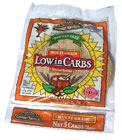
“Whey, soy and milk proteins are very high-quality proteins, yet each is unique,” says Shannon L. Koski, manager of protein applications for a protein supplier. “Whey proteins long have been a popular source of high-quality protein. The flavor is favorable, making it easy to formulate into products.”
“Consumers may not realize the differences in digestion patterns or advantages of different forms of protein, but they do know that protein is a healthy part of the diet and should be consumed,” says Koski.
An article on the Harvard School of Public Health's website informs that adults need a minimum of 1g of protein for every kilogram of body weight per day to keep from slowly breaking down their own tissues. That equals about 9g of protein for every 20 pounds.
“The Atkins craze heightened awareness of proteins in more mainstream applications,” notes Koski. Indeed, a search on Mintel International's Global New Products Database (GNPD) for the phrase “'soy protein isolate' (SPI) or 'whey protein isolate'” (WPI) on the label, reports that 1,023 new items (new products, new variety/range extensions or new formulations) were introduced in the U.S. alone between May 2003 and May 2006. Of those 1,023 new introductions, 906 contained SPI, 329 included WPI, and 375 had both WPI and SPI.
“As far as specific health attributes associated with proteins, I believe consumers are most aware of the relationship between soy protein and heart health, thanks to the FDA heart health claim,” says Koski. In 1999, the FDA approved a heart health claim for packaging labels that stated: “Diets low in saturated fat and cholesterol that include 25g of soy protein a day may reduce the risk of heart disease.” Originally, the American Heart Association (AHA) also approved this statement.
“The label claims associated with soy proteins are numerous, and have been instrumental in building the market for all types of soy protein-enhanced foods,” says Koski.

New Soy Suggestions
However, in early 2006, the AHA concluded that soy protein has little or no effect on risk factors for heart disease. The “change of heart” came after the AHA analyzed 22 clinical trials and found that large amounts of soy protein in the diet reduced LDL (bad) cholesterol by only 3% and had no effect on HDL (good) cholesterol, nor did soy protein or isoflavones lessen menopause symptoms.However, consumers should not “harden their hearts” to consuming soy proteins. Many other studies including the INTERMAP study, a cross-sectional epidemiological study of 4,680 persons, aged 40 to 59, from four countries, reported that vegetable protein intake was inversely related to blood pressure. In other words, as reported in the January 2006 issue of the Archives of Internal Medicine, “these results are consistent with recommendations that a diet high in vegetable products be a part of a healthy lifestyle for prevention of high blood pressure and related diseases.”
“Soy protein has been found to have many biologically active benefits,” says Koski.
Proteins seem to play an important role in many emerging health arenas. For instance, foods with higher protein contents are more favorable in terms of glycemic load. It has been established that the addition of protein will generally reduce the Glycemic Index (GI) of the meal. Additionally, a high-protein diet induces sustained reductions in appetite. “It can appeal to consumers who may not prefer dairy proteins.”
Nuts also provide a high source of protein and a complete package of benefits, which include fiber and mono- and poly-unsaturated fatty acids. The FDA approves the following statement for nuts: "Eating a diet that includes 1oz. of nuts daily can reduce your risk of heart disease."
Protein Functionality
Although health is generally the topic taking up most of the attention, manufacturers also are choosing to add proteins for functionality. “In ready-to-drink beverages, milk and soy proteins can add viscosity and mouthfeel without adding unnecessary fat,” says Koski. Additionally, soy proteins can bind water and act as emulsifiers in meat injection applications.Whey proteins have a desirable combination of hydrophobicity and hydrophilicity, letting them serve as emulsifiers that coat fat globules and prevent coalescence. When the protein is denatured, the hydrophobic groups in the interior become exposed, and the protein can stabilize emulsions. Additionally, milk proteins have a bland flavor profile and creamy white appearance, making them ideal for milky beverages and shakes.
Microparticulated protein products (made from whey protein or milk and egg protein) are tiny, spherical particles, which can provide a creamy mouthfeel similar to fats. Although not suitable for use in fried foods, these fat replacers provide 1Kcal/g to 4Kcal/g. For example, 1g of protein-based fat mimetics can replace 3g of fat in cream, according to information found on the website www.caloriecontrolcouncil.org. Protein blends combining animal or vegetable protein, gums, food starch and water are used in frozen desserts and baked goods as fat mimetics. Articles from the International Journal of Food Science and Technology report that a combination of protein, starches and hydrocolloids may have synergistic effects for lowering fat and retaining textural characteristics of the products.
Now that the low-carbohydrate phenomenon has passed, protein is more useful than ever. Consumers are more aware about the health benefits of protein, and manufacturers can view proteins as a useful tool for emulsification, fat-reduction and texturization.
SHOWCASE: PROTEINS


As formulators focus on the development of nutraceutical and healthier functional foods, the active ingredients utilized frequently result in less than optimal mouthfeel at the point of consumption. A proven approach to rebuilding desirable mouthfeel in many types of products is the use of Dairy-Lo®, a functionally designed whey protein concentrate, at low levels. Dairy-Lo delivers a pleasant fatty mouthfeel without significantly changing viscosity, creates a bright, white opacity and assists in developing a desirable texture and well-rounded flavor profile. Parmalat-Canada, Janice Cox, 416-620-3132, Janice_Cox@parmalat.ca
ULTRA-SOY® Textured Vegetable Protein is a dry soy product which, when hydrated, has the laminar, fibrous texture of meat. The ingredient is available in numerous shapes, sizes and colors to fit an assortment of applications. Adding ULTRA-SOY can increase product yields and improve handling properties in applications such as ground meat, sausage, seasoned meats and pizza toppings. ULTRA-SOY contains 50% protein, <1% fat, 16% dietary fiber and no cholesterol, saturated fat or trans fat. The protein also is rich in naturally occurring soy isoflavones. Legacy Foods LLC, Eric Hoskinson, 620-663-5711, ext. 223, ehoskinson@legacyfoods.com
